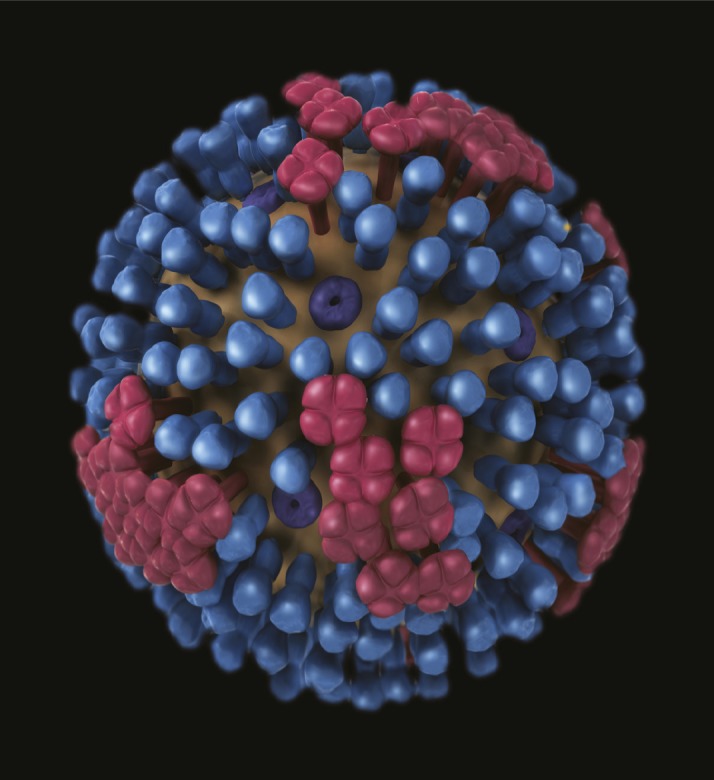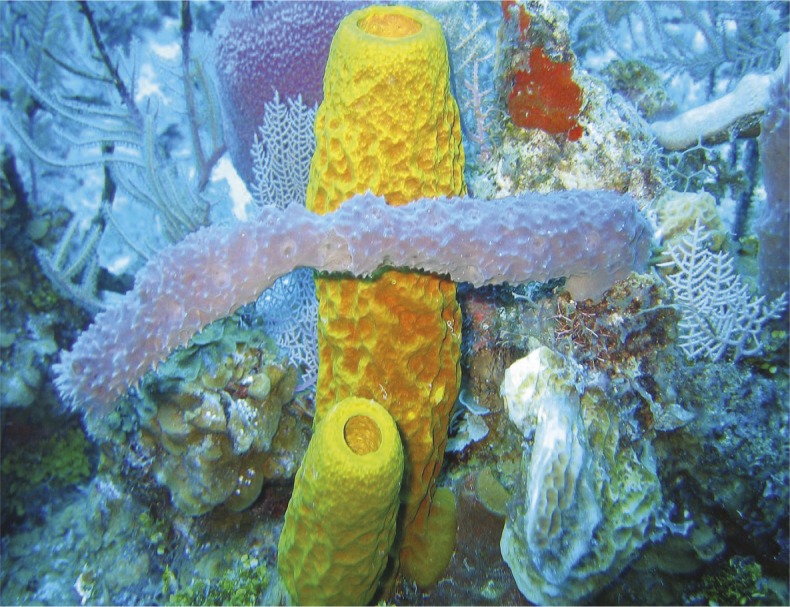Enhanced efficacy of adjuvanted influenza vaccine in children

3D graphic of generic influenza virion ultrastructure. Image courtesy of Dan Higgins/CDC.
Clinical trials have revealed that the efficacy of the seasonal trivalent inactivated influenza vaccine (TIV) in 6- to 72-month-old children is improved by the addition of the squalene-based MF59 adjuvant. However, the precise molecular signatures of innate and adaptive immune response to the adjuvanted vaccine remain unclear. Helder Nakaya et al. (pp. 1853–1858) conducted a phase II open-label, randomized controlled trial of adjuvanted and nonadjuvanted TIV in 90 healthy 14- to 24-month-old children during the winter of 2012–2013. Taking a systems biology approach, the authors measured the magnitude and kinetics of antibody generation, production of vaccine-specific CD4+ T cells, and gene expression signatures in response to vaccination. Compared with TIV, the adjuvanted vaccine boosted serum antibody levels, immune response kinetics, and levels of CD4+ T cells that secreted multiple cytokines, including TNF-α and IL-2, which are involved in antiviral immunity. Adding the adjuvant increased the consistency and robustness of gene expression tied to antigen presentation and antiviral immunity; the adjuvant also shifted vaccination-associated gene expression in the children to adult-like patterns. According to the authors, in addition to uncovering molecular correlates of vaccine-induced immunity in children, the findings underscore the role of the MF59 adjuvant in improving the efficacy of seasonal influenza vaccination in children. — P.N.
Human languages may share a common semantic structure
Researchers have attempted to develop methods to determine whether there are universal properties of human cognition that underlie the structure of human languages, or whether language is instead a reflection of culture or environment. Hyejin Youn et al. (pp. 1766–1771) empirically measured semantics and quantified how meanings compare between languages. The authors used cross-linguistic dictionaries from 81 diverse human languages and designed a model to analyze semantic similarities across languages. Further, the authors examined words related to material objects (stone, ash, sand), celestial objects (sun, moon, stars), natural settings (night, day), and geographic features (mountain, lake, river) that could be strongly affected by the environment in which a language evolved. By examining the words in each language that have multiple meanings and how those meanings are related to each other and to other words, the authors created semantic network maps. The semantic networks were found to be universal among human languages. For example, “sea/ocean” and “salt” are universally more closely related to each other than either is to “sun,” and this relationship held for languages at the coast and inland. According to the authors, concepts expressed in language may stem from universal properties of human cognition. — B.A.
Oxygen levels in the prehistoric atmosphere

Atmospheric oxygen levels may have been sufficient for sponge respiration hundreds of millions of years before sponges evolved. Image courtesy of the Twilight Zone Expedition Team 2007, NOAA-OE.
Researchers have long argued that oxygen levels on Earth first increased to sufficient levels for animal respiration during the Neoproterozoic Eon, 1,000–542 million years ago, thus explaining why animals first evolved during this period. Shuichang Zhang et al. (pp. 1731–1736) searched for geochemical evidence of oxygenation in 1,400-million-year-old sediments of the Xiamaling Formation in northern China. Shales with high total organic carbon were enriched in the redox-sensitive trace metals molybdenum and uranium, but not in vanadium. This pattern suggests bottom-water oxygenation during deposition of the sediment layers. The abundance of 2,3,6-trimethyl aryl isoprenoids indicates the presence of anaerobic green sulfur bacteria, suggesting that deposition occurred in an oxygen minimum zone. The authors used the observed geochemical data to constrain ancient oxygen cycling, from which they estimated atmospheric oxygen to be at least 3.8% of present-day levels. This amount is sufficient for respiration of sponges and certain small motile animals. The results suggest that oxygen levels sufficient for animal respiration existed on Earth approximately 1,400 million years ago, hundreds of millions of years before the first animals evolved. According to the authors, oxygen levels may not have restricted the emergence of animal life on Earth. — B.D.
Cellular model of insulin resistance
Obesity increases the risk of type 2 diabetes and cardiovascular disease through defective cellular responses to insulin. Insulin resistance is a growing public health concern, but the development of effective interventions has been limited by an incomplete understanding of the underlying molecular mechanisms. Salvatore Iovino et al. (pp. 1889–1894) developed a cellular model of insulin resistance in skeletal muscle tissue, which is affected during early stages of type 2 diabetes. The authors obtained skin cells from four healthy individuals and four patients with Donohue syndrome, which causes insulin resistance through mutations in the insulin receptor. Next, the authors genetically reprogrammed the skin cells into induced pluripotent stem (iPS) cells, which are capable of turning into multiple cell types. Upon exposure to a specific combination of chemicals, the iPS cells transformed into skeletal muscle fibers known as myotubes. Compared with myotubes derived from healthy individuals, the patient-derived myotubes showed not only a 90% reduction in levels of the insulin receptor but also impaired insulin signaling. Moreover, insulin treatment failed to trigger an increase in the activity of genes that regulate metabolism and growth in patient-derived myotubes. According to the authors, the iPS model of insulin resistance could help identify new therapies for type 2 diabetes and related diseases. — J.W.
Quasiparticle charge measurement in a Josephson junction
Quasiparticles are excited energy states in solids, a conceptual framework that exploits the equivalency of matter and energy to simplify complex quantum interactions among electrons. Condensed matter physicists study quasiparticle properties to better understand superconductivity; however, charge has proven difficult to measure because quasiparticles coalesce into pairs that increase and distort the charge density around them. Yuval Ronen et al. (pp. 1743–1748) investigated quasiparticle charge using a superconductor–insulator–superconductor (SIS) Josephson junction—two superconductors separated by a gated nanowire semiconductor—and highly sensitive measurements of time-dependent, low-frequency current fluctuations known as quantum shot noise. By observing shot noise over a wide energy regime, the authors detected charge in quantized multiples of an electron’s charge in tunneling current across the SIS junction. Further measurements revealed a relatively low value at the edge of the superconducting energy gap, which the authors attribute to the charge of a tunneling quasiparticle. This subelectron value aligns with theoretical predictions of Bogoliubov quasiparticles, a superposition of electrons and holes that should exhibit charges less than that of an electron. Though the findings are preliminary, the approach may help investigate quasiparticle charge in other superconductors, according to the authors. — T.J.


